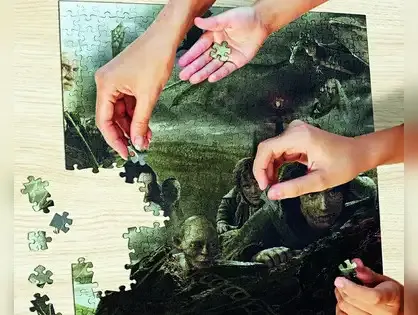Earlier this month, a startling proposal emerged from the Wild West of geopolitics and techno-capitalism, when a group of Israeli businessmen shared a plan with Donald Trump to parcel off land in war-torn Gaza as tokenised assets on blockchain and sell them to investors. Ludicrous and exploitative as it sounds, the proposal captures something essential about our age: we now increasingly understand the world not in physical terms but in tokens.
The token has become the most consequential five-letter word in tech, straddling both generative AI and blockchain-based crypto. Interestingly, while these technologies are often discussed in isolation, tokens may be the bridge that connects them.
Unit of intelligence Let's start with AI. In LLMs that power DeepSeek, ChatGPT and their ilk, tokens are the atomic units of understanding and intelligence. A token is not quite a word or letter - it's something in between that's the basic unit that a LLM works on. When we type into a GenAI model, it breaks and digests our input as tokens, and uses its fearsome power to predict the next one, spitting out an answer, token by token.
OpenAI co-founder Andrej Karpathy recently described this process in strikingly simple terms: LLMs are machines that turn electricity and data into tokens. They are generative factories ingesting the world's data and a lot of its power, and outputting knowledge and creativity in the form of tokens. These tokens constitute words, stories, code, emails, images, music, even 3D models. They are the currency of generative intelligence.
Nvidia's Jensen Huang takes it further with the concept of the 'AI factory'. Just as early factories turned coal and steel into machines, or electricity into appliances, these new factories convert computations and data into tokens. As Huang eloquently explains, 'You apply electricity to it and what comes flying out of it are tokens. And these tokens could be reformulated into numbers and words and proteins and images and videos.... We call it intelligence.'
So, in AI, tokens are not just units of language but also units of value. The more tokens you can generate with precision and relevance, the more 'intelligent' your system is. It's no accident, therefore, that OpenAI prices usage in tokens, not time.
Unit of ownership Now to blockchain. Here, a token is a digital representation of value or ownership. It can be fungible, like a bitcoin or stablecoin. Or, it can be non-fungible, like an NFT artwork or deed to a house. More excitingly, tokens allow for fractionalisation. You can divide a Picasso into a million digital shares or tokenise future royalties from a pop song.
The promise here is programmable value. Smart contracts allow tokens to behave according to rules - self-executing agreements encoded in blockchain protocols. This reimagines not just assets but also trust, identity and institutions. And with the recent rise of 'Real World Assets' (RWA) - physical or traditional financial assets that exist outside the digital realm but are represented digitally on a blockchain through tokenisation - we are witnessing an explosion of token-based financial models. BlackRock's Larry Fink calls it 'the next generation for markets'.
Even geopolitics and pop culture are getting tokenised. Trump launched a crypto coin themed around his campaign, instantly drawing millions. Meanwhile, countries like the UAE and Singapore are piloting tokenised green bonds, and India is exploring a central bank digital currency (CBDC), thus creating instruments of sovereignty.
Two worlds, one language At first glance, these two uses of tokens seem to be different. One is linguistic and cognitive; the other economic and legal. But on deeper thought, they are united by abstraction by distilling complex phenomena into discrete, manipulable units. In both AI and crypto, tokens let us compute meaning - in AI, the meaning of language and thought, in crypto, the meaning of ownership and value.
Interestingly, both technologies are distributed and decentralised in a fashion. LLMs are trained across server farms scattered globally, while blockchains are run by nodes around the world. Most importantly, both are reshaping our understanding of trust.
In GenAI, we trust the model to complete the next token correctly, and not hallucinate. In crypto, we trust the chain to verify a transaction immutably.
So, where can this curious convergence lead? Could the world be heading toward a unified token economy, where tokens not only represent value but also carry intelligence? Imagine an AI that not only generates content but also understands smart contracts, negotiates on your behalf and pays for services - all through tokens.
Your AI agent may negotiate your next vacation, using AI-generated planning and blockchain-based payment tokens. Or, another agent could issue a music licence, receive payment in stablecoins and update royalties via smart contracts - entire workflows tokenised from end to end.
These are still early days, but some early signals are worth watching. AI researchers are exploring autonomous economic agents that can hold wallets, transact and even invest. One could imagine a new class of AI-native economic entities - thinking, trading, building - all through tokens.
Tokens may become the new medium of power, defining who owns what - and, increasingly, who knows what. So, if data is the new oil, AI is the refinery, and tokens the refined product, which is traded, valued and consumed across sectors. What electricity was to the Industrial Revolution, tokens are to the Intelligence Revolution.
The token has become the most consequential five-letter word in tech, straddling both generative AI and blockchain-based crypto. Interestingly, while these technologies are often discussed in isolation, tokens may be the bridge that connects them.
Unit of intelligence Let's start with AI. In LLMs that power DeepSeek, ChatGPT and their ilk, tokens are the atomic units of understanding and intelligence. A token is not quite a word or letter - it's something in between that's the basic unit that a LLM works on. When we type into a GenAI model, it breaks and digests our input as tokens, and uses its fearsome power to predict the next one, spitting out an answer, token by token.
OpenAI co-founder Andrej Karpathy recently described this process in strikingly simple terms: LLMs are machines that turn electricity and data into tokens. They are generative factories ingesting the world's data and a lot of its power, and outputting knowledge and creativity in the form of tokens. These tokens constitute words, stories, code, emails, images, music, even 3D models. They are the currency of generative intelligence.
Nvidia's Jensen Huang takes it further with the concept of the 'AI factory'. Just as early factories turned coal and steel into machines, or electricity into appliances, these new factories convert computations and data into tokens. As Huang eloquently explains, 'You apply electricity to it and what comes flying out of it are tokens. And these tokens could be reformulated into numbers and words and proteins and images and videos.... We call it intelligence.'
So, in AI, tokens are not just units of language but also units of value. The more tokens you can generate with precision and relevance, the more 'intelligent' your system is. It's no accident, therefore, that OpenAI prices usage in tokens, not time.
Unit of ownership Now to blockchain. Here, a token is a digital representation of value or ownership. It can be fungible, like a bitcoin or stablecoin. Or, it can be non-fungible, like an NFT artwork or deed to a house. More excitingly, tokens allow for fractionalisation. You can divide a Picasso into a million digital shares or tokenise future royalties from a pop song.
The promise here is programmable value. Smart contracts allow tokens to behave according to rules - self-executing agreements encoded in blockchain protocols. This reimagines not just assets but also trust, identity and institutions. And with the recent rise of 'Real World Assets' (RWA) - physical or traditional financial assets that exist outside the digital realm but are represented digitally on a blockchain through tokenisation - we are witnessing an explosion of token-based financial models. BlackRock's Larry Fink calls it 'the next generation for markets'.
Even geopolitics and pop culture are getting tokenised. Trump launched a crypto coin themed around his campaign, instantly drawing millions. Meanwhile, countries like the UAE and Singapore are piloting tokenised green bonds, and India is exploring a central bank digital currency (CBDC), thus creating instruments of sovereignty.
Two worlds, one language At first glance, these two uses of tokens seem to be different. One is linguistic and cognitive; the other economic and legal. But on deeper thought, they are united by abstraction by distilling complex phenomena into discrete, manipulable units. In both AI and crypto, tokens let us compute meaning - in AI, the meaning of language and thought, in crypto, the meaning of ownership and value.
Interestingly, both technologies are distributed and decentralised in a fashion. LLMs are trained across server farms scattered globally, while blockchains are run by nodes around the world. Most importantly, both are reshaping our understanding of trust.
In GenAI, we trust the model to complete the next token correctly, and not hallucinate. In crypto, we trust the chain to verify a transaction immutably.
So, where can this curious convergence lead? Could the world be heading toward a unified token economy, where tokens not only represent value but also carry intelligence? Imagine an AI that not only generates content but also understands smart contracts, negotiates on your behalf and pays for services - all through tokens.
Your AI agent may negotiate your next vacation, using AI-generated planning and blockchain-based payment tokens. Or, another agent could issue a music licence, receive payment in stablecoins and update royalties via smart contracts - entire workflows tokenised from end to end.
These are still early days, but some early signals are worth watching. AI researchers are exploring autonomous economic agents that can hold wallets, transact and even invest. One could imagine a new class of AI-native economic entities - thinking, trading, building - all through tokens.
Tokens may become the new medium of power, defining who owns what - and, increasingly, who knows what. So, if data is the new oil, AI is the refinery, and tokens the refined product, which is traded, valued and consumed across sectors. What electricity was to the Industrial Revolution, tokens are to the Intelligence Revolution.
(Disclaimer: The opinions expressed in this column are that of the writer. The facts and opinions expressed here do not reflect the views of www.economictimes.com.)






Jaspreet Bindra
Founder, Tech Whisperer